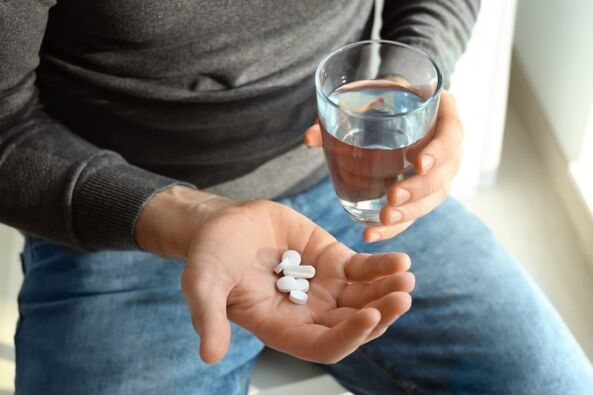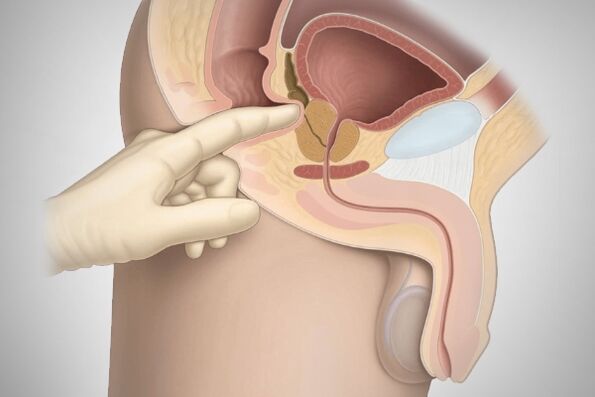Sometimes men suffer from an unpleasant disease such as bacterial prostatitis. In order to start treatment on time, it is important to know what symptoms the disease can be diagnosed with and what diagnosis and treatment will be needed.
Bacterial prostatitis is an infectious disease of the prostate gland. Symptoms of the disease include pain in the perineum, increase in body temperature, intoxication of the body and other symptoms. Such a situation may require emergency hospitalization as it may endanger the patient's health and life.
Forms of bacterial prostatitis
Depending on the course and the symptoms that occur, bacterial prostatitis is divided into two forms - acute and chronic.
Sharp
The acute form manifests itself unexpectedly and is accompanied by various unpleasant symptoms. Acute form of bacterial prostatitis requires urgent medical attention. This pathological process is provoked by Escherichia coli, staphylococci, enterobacteria.
Acute prostatitis is easily diagnosed by laboratory tests. Severe symptoms and clinical picture allow to make an accurate diagnosis. Treat this form of prostatitis in a complex way using medication and physiotherapy.
Chronic
Chronic bacterial prostatitis is a pathogen that can be identified by laboratory tests and studies. The main pathogens are gonococci, chlamydia, ureaplasma, mycoplasma. If a man has HIV infection, the inflammatory process can also be caused by tuberculosis bacteria or fungi of the genus Candida.
Types of bacterial prostatitis
Bacterial prostatitis is classified according to the type of pathogen:
- tuberculosis (Koch bacilli);
- gonorrheal (gonococci);
- fungi (various types of fungi);
- chlamydia (chlamydia);
- viral (pathogens of herpes, human papillomavirus, influenza);
- mixed (various infections).
Because the symptoms are the same for everyone, it is only possible to determine what the culprit is in a laboratory setting.
Causes and risk factors
Bacteria enter the prostate gland and cause acute or chronic prostatitis. Sexually transmitted diseases can also cause this disease. In some cases, it is not possible to determine the cause.
Cause agentsBacterial prostatitis is considered:
- colibacillus;
- klebsiella;
- Proteus;
- fecal enterococci;
- Pseudomonas aeruginosa.
Possiblemicrobiological causesProstatitis includes:
- staphylococci (saprophytic, gold, epidermal);
- genital mycoplasma;
- chlamydia trachomatis;
- ureaplasma;
- Trichomonas.
TOrisk factorsInfection of the prostate gland with the subsequent development of the inflammatory process in the form of one or another bacterial prostatitis:
- intraprostatic reflux (urine flow into the ducts of the prostate gland during urination);
- pelvic injury;
- unprotected anal sex;
- urinary tract infections;
- localized urethral catheter or interstitial bladder catheterization;
- transurethral diagnostic and therapeutic interventions;
- HIV AIDS;
- past prostate biopsy.
Symptoms of bacterial prostatitis
Usually, the symptoms of bacterial prostatitis are so obvious that it is difficult to ignore them. Symptoms include:
- high body temperature (generally higher in the anus than under the armpit);
- fire and vibration;
- difficult and painful urination, especially at night;
- possible development of constipation due to enlargement of the prostate gland;
- lower body pain (back, perineum, lower abdomen);
- general intoxication of the body;
- discharge from the urethra and blood in the sperm.

Stages of bacterial prostatitis
The clinical picture of bacterial prostatitis manifests itself depending on the stage of the disease and the degree of involvement of prostate tissue in the inflammatory process. Share:
- Primary or catarrhal prostatitis.It is characterized by inflammation of the walls of the prostate gland. It is quite possible to be treated with antibiotics for 10 days.
- Secondary or follicular.It is characterized by the formation of abscesses in the glandular tissue. Accompanied by high fire. This form is also effectively treated with antibacterial drugs.
- Third or parenchyma.The pathological process at this stage spreads throughout the body - the prostate grows in size, swells and changes shape. If not treated in time, the third stage can turn into chronic prostatitis.
Possible complications and consequences for men
Complications and consequences of bacterial prostatitis are as follows:
- vesiculitis (inflammation of the seminal vesicles) - manifests itself in groin pain, premature ejaculation, painful erection;
- colliculitis (inflammation of the seminal tubercle) - differs in various symptoms - burning and tickling of the posterior urethra, painful sensations during orgasm, blood in the semen;
- potential impairment;
- prostate sclerosis;
- infertility;
- prostate cyst;
- prostate abscess;
- stones in the prostate gland.
Chronic pelvic pain syndrome is one of the most serious consequences of chronic prostatitis.
Asymptomatic inflammation is the mildest form in the absence of any complaints. This type of prostatitis is diagnosed as a complication of reproductive function.
Is bacterial prostatitis dangerous for women?
Prostatitis does not occur in women, but its serious consequences are very common. If a man is affected by bacterial prostatitis, it is simply irresponsible to say that a woman is not in danger: chlamydia, ureaplasma, Trichomonas, mycoplasma, gonococcus, gardnerella and other infections from her partner pose a serious threat to the woman. and causes the development of various gynecological diseases.
Which doctor is treating you?
Urologistis the main specialist in the diagnosis and treatment of pathological conditions of the genitourinary system.
Andrologist.Although andrology is a relatively young field of medicine, specialists in this field are gradually taking their place in the treatment of diseases of the male genitourinary system. The advantage of this doctor is the narrow focus. Unlike a urologist who treats diseases of the male and female genitourinary system, an andrologist only deals with male problems.
Diagnosis of bacterial prostatitis
If you suspect bacterial prostatitis, a number of tests are performed, including:
- crumbs and sticks for infection;
- plants for flora and sensitivity to antibiotics;
- general blood test helps to detect the inflammatory process when there is an increase in the number of leukocytes, an increase in ESR;
- spermogram, which examines the decrease in the number of sperm, impaired motility;
- three bottles of urine sample (studies inflammatory changes in urine);
- general urinalysis;
- analysis of prostate secretion;
- uroflowmetry - to observe the amount of urine daily.
The doctor will be able to assess how large the prostate is with a digital rectal examination. Your doctor may refer you for a transrectal ultrasound to confirm the diagnosis.
Treatment of bacterial prostatitis
Treatment of bacterial prostatitis is prescribed drugs, physiotherapy, folk remedies, and in severe cases, surgery.
Drug treatment
Medical treatment of prostatitis is carried out using different groups of drugs. These can be antibiotics to neutralize the pathogen. However, they do not always help, because the prostate gland is characterized by poor absorption of antibiotics from the group of protected penicillins, fluoroquinolones.
The course of treatment is usually 10-14 days, and bacterial prostatitis will reappear if left untreated. Vitamins and medications are also prescribed to strengthen the immune system.

Surgical intervention
The doctor suggests surgery for prostatitis when there is no result in treating the patient with medication, physiotherapy or alternative therapies.
Surgical intervention includes the following procedures:
- Transurethral resection of the prostate.The inner part of the body is removed. Surgery is the most widely used and best endoscopic treatment for benign prostatic hyperplasia.
To perform this intervention, the patient undergoes a series of tests, including blood and urine tests. The operation is performed under spinal anesthesia, but general anesthesia can also be used. There are no scars after the operation. Among the disadvantages is painful urination in the first days after the procedure. - Laser surgery.The laser destroys diseased tissues. At the same time, the size of the prostate decreases and the veins are "sealed" and do not bleed. The operation is performed without incisions, and the postoperative period is only three days. Prior to the intervention, blood and urine tests are performed, as well as an ultrasound of the urinary tract and a prostate biopsy as directed by a physician.
This method is not effective when the prostate is large. - Open prostatectomy.The operation is performed in cases of large enlargement of the prostate, complications and damage to the bladder.
The surgeon makes an incision either under the abdomen or between the scrotum and anus. Either part of the prostate is removed or completely removed.
Prior to surgery, ultrasound, MRI and cytoscopy, blood and urine tests, and a prostate-specific antigen test are performed.
One of the advantages of the operation is that it is effective in the treatment of prostate and related problems. And the disadvantages - a long postoperative recovery period (more than a month), as well as problems with erectile function. - Transurethral section of the prostate gland.The doctor does not remove the prostate tissue, but cuts it to reduce the pressure on the urethra, making it easier to urinate. Blood and urine tests are performed before the operation, as well as ultrasound of the urinary tract.
Advantages of the procedure - the symptoms of prostatitis are eliminated without the risk of retrograde discharge, long-term recovery is not required. Of the defects - prostatitis still needs treatment. - Drainage of the prostate abscess.The doctor opens the abscess from the perineum or rectum, dissects the skin and subcutaneous tissue, and places a drain in the purulent cavity for removal.
Before the operation, a proctologist is consulted, blood and urine tests are performed.
Among the advantages of the operation is the absence of the risk of loss of sexual function. The disadvantages are that the abscess is not completely removed and the bacteria can spread throughout the body.
In men, prostatitis surgery is usually the last resort for chronic bacterial prostatitis associated with complications of any form.
Physiotherapy
Methods of physical therapy are of great importance in the complex treatment of patients diagnosed with prostatitis. As a result of physiotherapy procedures, the following improves:
- blood flow;
- lymphatic drainage, which helps to eliminate putrefactive products of microorganisms;
- blood and lymph circulation, due to which inflammatory infiltrates are resolved;
- blood and lymph flow, which helps reduce pelvic congestion;
- metabolism;
- activity of cell membranes that promote the penetration of active drugs into the cell.
Physiotherapy for bacterial prostatitis includes the following methods:
- Electrophoresis.Effects on the body with ions that help relieve inflammation and relieve pain.
- Laser physiotherapy.The laser helps relieve perineal pain and improve blood flow to the pelvic organs. Kills bacteria and removes waste products of pests.
- Magnetotherapy.During this procedure, tissue permeability is improved and the effectiveness of drug treatment is significantly increased. In addition, magnetotherapy stops hemodynamics and congestion.
Exercise for bacterial prostatitis
Exercise for chronic prostatitis causes the muscles of the pelvic region to contract, which provides a difference in intra-abdominal pressure. It stimulates blood flow to the prostate. Exercise tones the nervous system, activates the adrenal glands and eliminates the residual effects of inflammatory diseases of the prostate.
You can do the following exercises at home:
- The man sits on a rubber ball and rolls a little, rolling from left to right. Helps strengthen pelvic floor muscles and obliques.
- Kegel exercises. Tighten your hips as much as possible for 5-10 seconds and then relax your muscles. This exercise is performed 20-50 times.
- Lie on your back, bend your knees and place your ankles on the ground. Slowly lift your pelvis, placing your upper back on the floor. When the pelvis is at the top, freeze for 15 seconds and then return to its original position. The number of repetitions is 10-15 times.
To massage
Exercises are performed every day to achieve the result and are complemented by prostate massage, which can be done both independently and with the help of special masseurs.
Prostate self-massage is performed as follows:
- For one liter of water one hour before the procedure to fill the bladder.
- Cleanse the intestines with an enema based on an infusion of potassium permanganate or chamomile. The shoulder should be washed.
- Hands should be washed thoroughly and nails should be cut short.
- You should wear a massage glove or condom on your finger.
- The rubber surface of the protective layer is lubricated with petroleum jelly, oil or baby cream.
- Lie down in a comfortable position and insert your finger into the anus to a depth of 5 cm.
- On the anterior wall, you can feel the prostate gland and begin to stimulate it with light strokes from the sides to the center.
- The pressure gradually increases in hard areas and decreases in soft areas.
- In the last stage, downward movements are made along the central sulcus.
- Gently pull your finger out of the anus.

3-5 drops of fluid (prostate juice) should be released during the massage. Immediately after the massage, go to the toilet and empty the bladder.
Dietary treatment
With prostatitis, alcohol and smoking should be reduced as much as possible. Doctors recommend exclusion from the diet:
- fatty foods, especially meat, because fat is a source of "bad" cholesterol, which disrupts blood circulation and adversely affects the prostate;
- synthetic and energy drinks;
- spices;
- spicy and smoked.
It is recommended to eat boiled and steamed dishes, lots of vegetables and herbs.
Folk remedies
Pumpkin seeds.Pumpkin seeds are an old remedy for prostatitis. They contain a lot of zinc that the male body needs. You need to eat 30 seeds every day before meals.
Hazelnut twigs.Boil a few hazelnut twigs with leaves in water for 20 minutes, infuse until the broth turns reddish-brown. One weekly course is enough for one treatment.
Aspen bark.Aspen bark should be collected at the beginning of the sap flow, before the buds bloom. This is about the second half of April. Dry the peel in the oven, take 100 g, grind and put in a half-liter jar. Pour 200 g of vodka to completely cover the crust. Close the jar and put in a dark place for 2 weeks. Strain after 2 weeks. Take 1 teaspoon 10 days apart in three courses of three days.
Prognosis for bacterial prostatitis
The prognosis of bacterial prostatitis depends on the stage and type of disease. The duration of the disease also affects the prognosis - the longer the inflammation persists, the longer it takes to treat prostate complications.
The prognosis in acute prostatitis is favorable. Chronic bacterial prostatitis is a common form of recurrence, even if conservative treatment is prescribed. Potential changes may occur with long-term treatment of the chronic form.
Prevention measures
Prevention of bacterial prostatitis can be divided into primary and secondary.
Primary prevention of prostatitis:
- healthy lifestyle;
- good nutrition;
- play sports.
Preventive measures at home are important - do exercises that activate blood flow to problem organs and improve muscle tone.
Men should also learn Kegel exercises. Formulated for postpartum recovery in women, but used to train male anal muscles and rectum.
Gymnastic exercises are useful: bicycle, maple, bridge, candles. They train the pelvic muscles. It is recommended to shake your legs, do breathing exercises and take a contrast shower.
Secondary prevention of prostatitis:
- drug treatment;
- regular examination by a urologist, regardless of its manifestations;
- one year after treatment, undergo quarterly examinations, then - once every six months.
Rectal suppositories are used for secondary prevention. They move through the rectum. Usually, these drugs have few contraindications. In addition, biologically active drugs are prescribed to prevent recurrence of bacterial prostatitis.
The sooner prostatitis is detected, the easier it will be to treat. Therefore, do not neglect regular visits to the doctor. After the diagnosis, the doctor will select the appropriate medication and prescribe a course of treatment. If the disease progresses, taking the medication on time will quickly relieve the symptoms and help you stay active and functional.
































